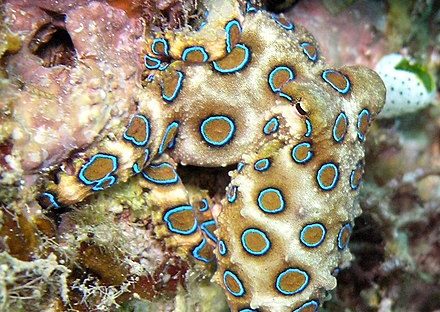Brooke Whitelaw led a fantastic study investigating species diversity in the iconic blue-ringed octopus genus, Hapalochlaena. Using genome-wide SNP data and mitochondrial loci, Brooke found 11 relevant taxonomic units – likely all species, suggesting MUCH greater diversity than is currently described! The origin of the genus Hapalochlaena was predicted to be in the Indo-Australian Archipelago and is older than you might thing ~30 mya.
The paper is published in Molecular Phylogenetics and Evolution and you can access it here.

Fig. 2. Delineation of Hapalochlanea species boundaries and genetic structure throughout the Indo Pacific using 10,346 SNPs: (a) SVDQuartet phylogeny of Hapalochlaena throughout the Indo Pacific generated using 10,346 SNPs, coloured branches represent putative taxonomic units A-K: brown (A/Southern coast of Australia), lilac (B/NSW), apple green (C/Taiwan lined), pink (D/Taiwan ringed), light orange (E/Darwin, NT & Kimberly & Exmouth, WA), red (F/Timor Leste), dark orange (G/G* Great Barrier Reef, QLD), purple (H/Cape York, QLD & Shark Bay, QLD) light blue (I/Deep water Yeppoon, QLD & North West, WA), dark blue (J/North West Shelf, WA) and light green (K/Ningaloo, WA). Posterior support values > 0.90 present on nodes. Bars at terminal branches indicate admixture of OTUs inferred using STRUCTURE, colours approximately correspond to OTUs. Lined box adjacent to OTU indicated lined markings while, OTUs without a box exhibit ringed markings. (b) Species delineation using the mitochondrial COI gene. Bayesian phylogeny (MrBayes) of Hapalochlaena throughout the Indo Pacific is coloured according to OTU with black used to represent taxa included from NCBI. Boxes represent putative species in accordance to sPTP, GYMC SC (strict clock) and GYMC RC (relaxed clock) methods. Boxes with diagonal lines represent specimens with lined markings as opposed to rings present in all other specimens. (c) Arrangement of samples according to the first two principal components of a PCoA based on SNP data generated using the dartR package. (d) Map of sample locations coloured by organisational taxonomic units A-K. (For interpretation of the references to colour in this figure legend, the reader is referred to the web version of this article.)
